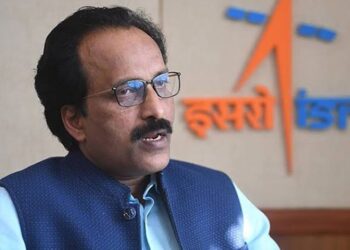The year 2023 could be characterized as an interplanetary mission year for India’s space agency, the Indian Space Research Organisation (ISRO).
After launching a trip to the Moon on Friday, India’s space agency will launch a mission to the Sun.
ISRO will launch its Aditya L1 coronagraphy satellite on a Polar Satellite Launch Vehicle (PSLV)/rocket at the end of August to research the solar atmosphere.
According to ISRO, the spacecraft will be positioned in a halo orbit around the Sun-Earth system’s initial Lagrange point, L1.
The satellite orbiting the L1 point has the significant benefit of continuously observing the Sun without occultation or eclipse. The Adiyta L1 mission is scheduled to take place a few days after ISRO attempts to touchdown its lander on the lunar surface using the Chandrayaan-3 spacecraft.
ISRO launched the Chandrayaan-3 satellite into orbit on Friday using its heavy lift rocket LVM3.
According to ISRO Chairman S. Somanath, the Moon lander is scheduled to touchdown on the lunar surface around 5.47 p.m. on August 23.
The European Space Agency (ESA) has announced that it will provide tracking assistance for ISRO’s next interplanetary mission, Sun Mission Aditya L1, a solar observatory set to launch at the end of August.
Aditya-L1 is named after the Hindu Sun god, who will be the spacecraft’s future home, and L1, the first Lagrange point of the Earth-Sun system. It will investigate a variety of features, including the dynamics and origins of coronal mass ejections, according to the ESA.
The ESA will assist Aditya-L1 by tracking activities from Kourou and Goonhilly. It will also receive assistance from the ESA’s largest antennae, the three 35-metre deep space antennas located in New Norcia, Australia, Malargue, Argentina, and Cebreros, Spain.
ESA uses these stations on a daily basis to interact with its growing fleet of Solar System explorers like as Juice, BepiColombo, and Solar Orbiter, as well as space observatories such as Gaia and the newly launched Euclid. They also provide assistance to ESA institutional and commercial partners.
“ESA Flight Dynamics experts were also involved in the support to Aditya-L1. ESA assisted with the validation of the ‘orbit determination’ software that ISRO will use for the Aditya-L1 mission. This software is vital for calculating exactly where your spacecraft is in order to communicate with it and calibrate its scientific instruments,” the ESA said.
ISRO has also slated a flight to Venus — Venus Mission — in 2024. Whether it is going to be a ‘Night Flight to Venus’ will be known later.
Source:IANS








 Finance
Finance






